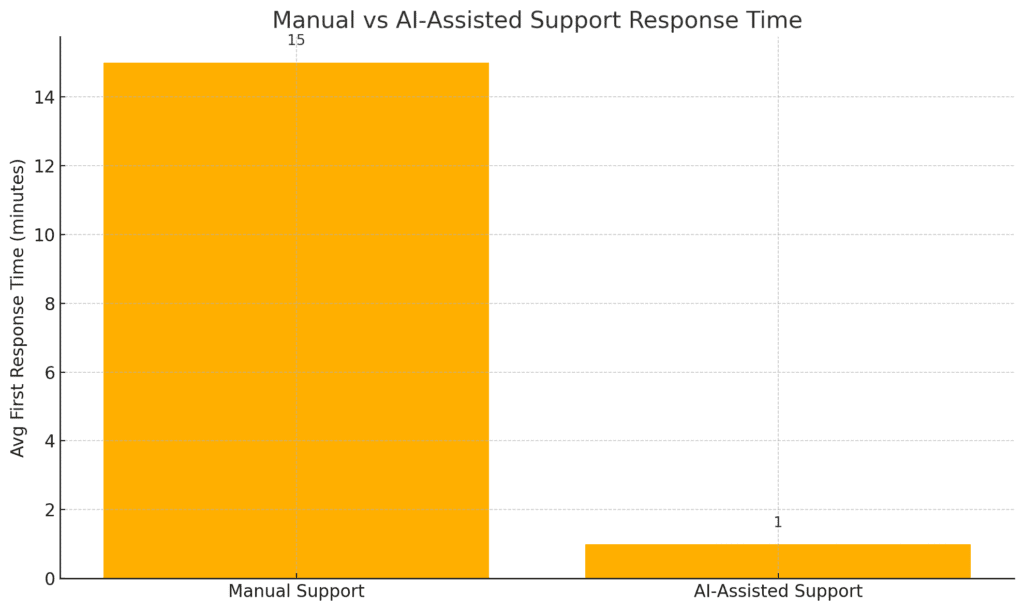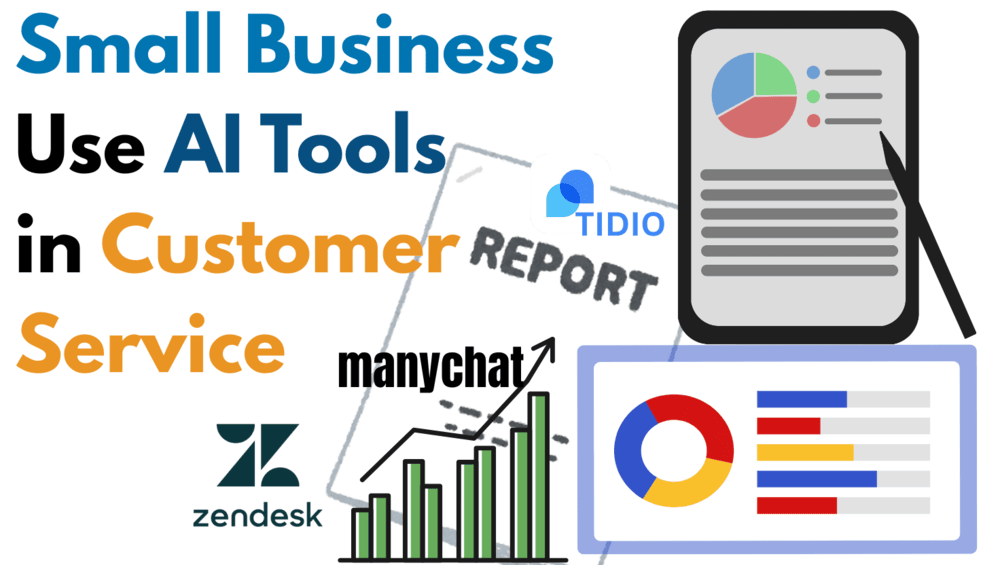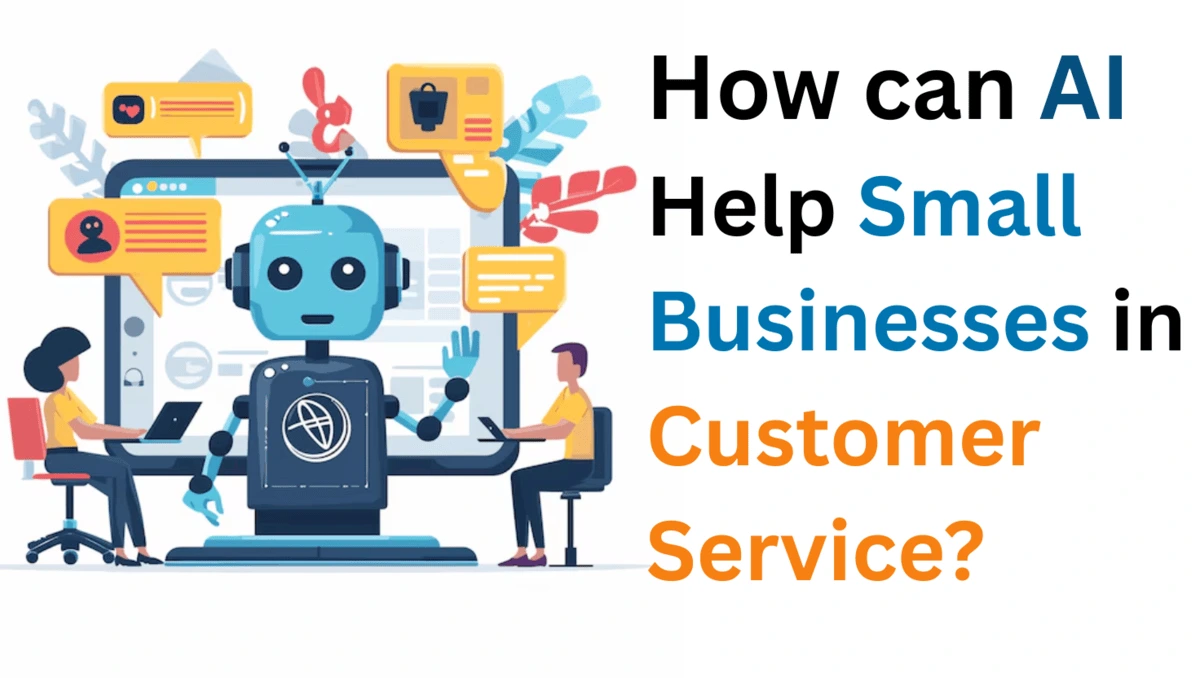Table of Contents
From researching dozens of AI tools for customer support, I have noticed one common trend: simplicity and cost matter most to small teams. Keeping customers happy is the lifeblood of any company, yet providing round-the-clock, high-quality support can seem impossible for a neighborhood bakery, boutique agency, or two-person SaaS startup. Limited staff, unpredictable ticket volumes, and constantly switching between email, phone, live chat, and social media make consistency a daily struggle.
This is where the question “How can AI help small businesses?” becomes practical. Over the past few years, pay-as-you-go tools have pushed enterprise-grade AI in customer service directly into the hands of small teams. Affordable AI chatbots for business now welcome website visitors 24/7, automated sentiment analysis flags frustrated emails before they escalate, and low-code workflows prioritize incoming requests so humans only step in when empathy or complex judgment is needed. The result is faster first-response times, fewer repetitive tasks, and a more personal touch, ironically delivered at scale through intelligent software.
In this post you will learn:
- The key building blocks of customer support automation from chatbots to AI-powered help-desk routing.
- The ROI metrics that matter when every rupee counts.
- A starter roadmap for piloting, measuring, and expanding AI without disrupting daily operations.
Finally, you will see how AI can help small businesses turn limited resources into smarter, more human-centric support, so you can spend less time putting out fires and more time delighting the customers that keep your business thriving.
Why Customer Service Is Critical for Small Businesses
I. Happy customers equal healthy cash flow
For emerging brands, marketing budgets are low and every interaction matters. When buyers feel listened to, they buy again, tell friends, and leave great reviews, organic advocacy you can never buy. Studies show that increasing retention by just 5 percent can increase profits by 25-95 percent, a lifeline for organizations running on tight margins. In other words, customer satisfaction and loyalty are not “nice-to-have” things; they are your cheapest growth engines.
II. The everyday hurdles of a lean support desk
Most small teams play multiple roles, so service queues grow quickly. Common barriers include:
- Limited staff – The same agent often serves as marketer, account manager, and IT help.
- High inquiry spikes – Launches or seasonal peaks fill inboxes in a matter of hours.
- Slow response times – Manual triage means customers wait longer than the tolerances set by big brand experiences.
- Knowledge silos – Answers stay in one team member’s mind or in scattered documents, making hand-offs a mess.
Left unchecked, these friction points reduce trust and revenue.
III. Rising expectations in the always-on era
Because of Amazon-style instant gratification, even tired parents expect a 24/7 reply, channel-hopping from WhatsApp to Instagram DM without repetition. They evaluate a brand not based on its peers, but based on the best interaction they had yesterday, anywhere online. Meeting that benchmark manually is tedious and costly.
So, how can AI help small businesses bridge this gap? By providing affordable tools, such as AI chatbots for business, smart routing, and full-stack customer support automation, owners can enhance hospitality service without increasing the number of employees. The next section discusses AI in customer service tips you can implement in a matter of days, not months.
How Can AI Help Small Businesses in Customer Service?
Below are four practical, real-world ways AI adds value to everyday support functions without busting the budget or tech stack.
A. 24/7 Availability with AI Chatbots for Business
Even small teams can feel “always on” when an AI chatbot delivers basic information. Trained on your FAQs, shipping policies, and product specifications, a bot can:
- Handle routine questions quickly—order status, return instructions, appointment changes.
- Capture leads while you are sleeping—collect emails or book calls instead of leaving forms idle.
- Reduce overhead—a subscription costs far less than hiring staff around the clock.
Tidio for easy Shopify/WordPress installs, Drift for B2B sales conversations, and Intercom for deeper CRM-style engagement.
Why it matters: Faster responses lead to higher satisfaction scores and fewer cart abandonments, key wins when every customer counts.
B. Customer Support Automation for Efficiency
Beyond chat, AI can choreograph the entire ticket lifecycle:
- Smart triage and routing – NLP models read each email or web form, tag the issue, and send it straight to the right queue or agent.
- Suggested replies – Auto-drafted answers reduce handle time without sacrificing empathy.
- Automated follow-ups – Send status updates or satisfaction surveys on a schedule.
These “set-it-and-forget-it” workflows lead to shorter wait times, reduced backlogs, and happier agents who spend their time on complex issues – exactly what customer support automation should deliver.
C. Personalized Support Using AI in Customer Service
Small businesses can now give enterprise brands the VIP treatment previously reserved for high-value accounts:
- 360° customer view – Machine-learning dashboards combine purchase history, browsing behavior, and sentiment analysis.
- Predictive recommendations – “You bought X, you might need Y next month” emails repeatedly boost sales.
- Context-rich chat – The bot (or human agent) looks at past interactions and talks to customers like old friends.
The net result: customized experiences that strengthen loyalty and increase average order value, without hiring a data science team.
D. Multilingual and Omnichannel Support
Your audience is already chatting on WhatsApp at 10pm and scrolling Instagram at 7am. AI meets them where they are:
- Real-time translation – Serve Hindi, Spanish or French speakers without bilingual staff.
- Channel integration – Plug the same bot into Messenger, WhatsApp and your website so conversations feel seamless.
- Consistent knowledge base – One source of truth feeds every channel, preventing contradictions.
Reach broader markets, break down language barriers, and keep the brand voice cohesive no matter when or where the conversation starts.
Leveraging AI does not mean replacing human warmth; it means automating repetition and bringing practicality to the fore so your team can focus on building real relationships. Implement one use case at a time, track critical metrics (response time, CSAT, conversion rates), and watch customer service transform from a cost center to a competitive edge.
Here is a comparable bar chart between Manual vs AI-Assisted Support Response Time

Gartner predicts that by 2026, 75 % of customer conversations will be handled by AI agents. (gartner.com)
How Small Businesses Can Use AI Tools to Improve Customer Service
If you are still asking “how can AI help small businesses” to provide the support customers want, the answer is: in a systematic way. A little structure at the beginning prevents purchasing tech for the sake of tech and keeps the budget under control. Use the five-step path below as your launch pad.
Identify service gaps
List the moments in your current customer journey that cause the most frustration, long waits on Mondays, repeated “where is my order?” questions, silence after hours, etc. Rank each gap based on (a) how often it happens and (b) how much revenue or satisfaction it costs you. This ranking is your AI priority map.
To identify high-impact starting points, refer to the Salesforce SMB Trends Report on small business AI adoption. It highlights which AI use cases are driving real ROI across industries.
Choose AI Tools Based on Needs
Use this table to list vendors whose strengths align with your top gaps
| Gap | AI approach | Typical Results |
|---|---|---|
| Simple FAQs | Rule-based or hybrid chatbots | Instant answers, fewer tickets |
| High-volume email/ticket queues | Generative support copilots | Auto-drafted replies, triaged tickets |
| Multichannel hand-offs | AI routing & sentiment analysis | Faster first-response + happier agents |
| Deep product troubleshooting | LLM-powered agents with action APIs | End-to-end resolutions without human hand-off |
If you are launching your first chatbot, the HubSpot guide on training AI chatbots provides practical setup steps. It includes tips on aligning chatbot tone with your brand and preparing for smooth human hand-offs.
Start small, prove value fast
Pick a “quick-win” use case (most teams choose chatbots for FAQs). Launch it with a clear success metric. For example, “eliminate 30% of repeat tickets in 90 days.” Celebrate and promote early wins internally; they build momentum for bigger automation later.
Upskill and reframe your team
AI does not replace humans; it repositions them, train agents:
- Review and refine answers generated by AI instead of typing them from scratch.
- Escalate sensitive or emotional conversations that a bot should not handle.
- Give AI constant feedback so it can learn your tone, policies, and edge-cases.
Zendesk reports that its AI agents now handle up to 80% of routine conversations, freeing live representatives for higher-value work. (zendesk.com)
Iterate, measure, repeat
Track deflection rate, CSAT, first-response time, and cost per ticket monthly. When performance stabilizes, complete the next gap on your priority map.

AI Tools for Customer Support Automation in Small Businesses
Beginner-Friendly Tool Kit
| Tool | Why it is SMB-friendly | Free/Trial? |
|---|---|---|
| Intercom Fin | LLM-powered agent that plugs into any help-desk and resolves complex queries end-to-end (fin.ai) | Yes |
| Zendesk AI | Pre-trained “AI agents” plus intent-based routing; lives inside the popular Zendesk suite (zendesk.com) | 14-day |
| Freshdesk Freddy AI | Ticket triage, email summaries, and agent copilot features geared toward small teams (freshworks.com) | Free tier |
| Tidio | Combines live chat, email, and AI chatbots for e-commerce; no-code setup (tidio.com) | Free |
| ManyChat AI | Social-messaging automation (Instagram, WhatsApp, Facebook) with new AI autoresponder (summitpartners.com) | Free |
Read Also, Top 10 free AI Tools for Small Business and give your customers a reason to stay loyal today.
Benefits vs. Limitations of AI in Customer Service
The upside—why AI seems like a super-power for small teams
- Always-on availability – AI chatbots for business can answer common questions at 2 a.m. without a yawn, reducing wait times and keeping global shoppers happy.
- Scale without additional staff – With customer support automation, one human agent can oversee dozens of simultaneous chats, freeing up people for granular issues.
- Data-driven insights – AI in customer service silently tags sentiment, persistent issues, and upsell signals, intel you can feed directly back into product or marketing.
- Consistent tone and compliance – Bots never forget your brand voice or latest refund policy, reducing the risk of accidental promises.
The flip side—where caution (and humans) still matter
- Context gap – Even the best models can misinterpret sarcasm or emotion, turning a disappointed customer into a ghosted former customer.
- Training and maintenance – You will need to keep the knowledge base fresh and monitor output; set-and-forget is a myth.
- Escalation friction – If the hand-off to a live agent is not seamless, customers get stuck in the “bot loop.”
- Cost vs. ROI for niche volumes – For very low ticket volumes, the subscription fee may outweigh the savings.
Future Outlook: AI’s Growing Role in Small-Business Success
When you ask, “How can AI help small businesses?” the honest answer is “as an assistant.” Let the bots handle the repetitive 70% while humans jump in for the messy 30%. Treat AI as a supporting system, not a replacement and you will get happier customers and happier employees.
Trends to watch
- Generative AI becomes the backstage writer – ChatGPT-style co-pilots will draft knowledge-base articles, summarize support threads, and suggest empathetic answers, cutting down response times without losing brand voice.
- Voice assistants step up as the new front desk – With >95% speech-to-intent accuracy, smart IVRs greet callers by name, route them instantly, and even upsell no elevator-music limbo required.
- Emotionally intelligent AI raises the bar – Real-time sentiment analysis now reads tone, pace, and word choice, letting AI chatbots for business know when to move on or offer a cool discount code.
How staying updated can provide a competitive edge
- Early adopters win mindshare – Small firms asking “How can AI help small businesses right now?” can deliver enterprise-level experiences before competitors get ahead of them.
- Data compounds – The sooner you introduce customer support automation, the faster your models understand the quirks of your audience, an advantage newbies can not afford.
- Teams stay motivated – Continuous training on AI in customer service turns rote ticket solvers into strategic problem-solvers, boosting retention.
Some Real-World Examples: Small Businesses Using AI Successfully
Are you wondering how AI can help small businesses beyond theory? Here are three small stories that prove smart technology is not just for the Fortune 500.
1. GlowUp Organics (Mumbai, India)
Industry: D2C skincare
Tool: Tidio AI chatbot + Shopify integration
Challenge: 25% of support tickets were basic questions like “Where is my order?”, which were troubling the two-person team.
Result:
- Automated 70% of order-status queries within 30 days.
- First response time reduced from 4 hours to less than 2 minutes.
- Monthly support costs were cut by ₹18,000, which the founders reinvested in product R&D.
2. Bean & Leaf Cafe (Portland, USA)
Industry: Specialty coffee roaster with an online store
Tool: Intercom Fin AI + Help Center
Challenge: Growing e-commerce sales meant global customers asking about grind sizes, shipping, and roast profiles.
Result:
- The AI suggested answers taken from the FAQ, giving baristas instant snippets to use personally.
- CSAT increased from 82% to 94% in one quarter.
- The team reclaimed 6 barista-hours per week enough to launch a new “brew-at-home” webinar series.
3. Tiny Trails Gear (Auckland, NZ)
Industry: Outdoor equipment rental
Tool: Zendesk AI for Intent Detection + WhatsApp API
Challenge: Holiday messages went unanswered and bookings were lost due to seasonal surges.
Results:
- Intent detection led to instant fare changes being sent to a live agent, while common queries were automatically resolved.
- Conversion rates on WhatsApp inquiries increased by 18%.
- In the off-season, the owner now runs pop-up demos instead of burying himself in the inbox.
Conclusion
So, how can AI help small businesses get ahead in customer service? In simple terms, it is by making support smarter, faster, and more efficient. From AI chatbots that provide 24/7 support for the business to customer support automation that reduces human workload, the benefits are both immediate and long-term. With the right tools, even small teams can deliver big results.
Still wondering where to start? Take a step back and evaluate your current customer service approach. Are your customers waiting too long? Are your employees too engaged? These are signs that it is time to explore AI solutions.
Be ready to take a step – Discover affordable, easy-to-integrate AI tools designed specifically for small businesses. Empower your support team and your customers with better service today.
Read Also– Ultimate Guide for AI Tools for Small Businesses in 2025
FAQs (Frequently Asked Questions)
Q.1. How can AI help small businesses improve customer service?
Ans. AI helps small businesses by automating repetitive support tasks, providing 24/7 support via chatbots, and analyzing customer interactions to provide faster, more personalized responses. This means better service with less manual effort.
Q.2. Are AI customer service tools affordable for small businesses?
Ans. Yes, many AI tools are budget-friendly and scalable. Options like AI chatbots, automated helpdesk platforms, and CRM integrations are often priced for small teams and offer free trials or pay-as-you-grow plans.
Q.3. What are the best AI tools for small business customer support?
Ans. Some popular tools include ChatGPT for automated answers, Tidio and Freshchat for live chat support, and Zoho Desk or HubSpot for AI-powered ticket management. The right tool depends on your specific business needs.
Q.4. How does AI improve customer satisfaction?
Ans. AI reduces wait times, ensures consistent responses, and makes customers feel heard immediately. With smart routing and personalized interactions, your customers are more likely to stay loyal and satisfied.
Q.5. Can AI completely replace human customer service agents?
Ans. No, AI is great for handling frequently asked questions and simple queries, but human agents are still necessary for complex issues, emotional intelligence, and relationship-building. Think of AI as a supporting system, not a substitute.
Read Also – In 2025, AI agents the next big wave in artificial intelligence


2 thoughts on “How can AI help Small Businesses in Customer Service? A Practical Guide”